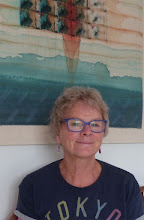Two recent textual collages of my response to emotional experience.
It may be really obvious to say this but I've recently discovered that as I create these textual collages about my recent experiences on Arran, as a way of 'visual thinking', that unless I write notes as I create, then subsequent writing about them can only be an interpretation of the visual content.
Yes, I know this sounds obvious, but it wasn't intentionally done. I hadn't realised what a difference it would make. I found that such was my intense feeling at the time, I couldn't write, I just had to make, with my hands, touch familiar materials and do it all intuitively, Writing would have been out of place within this action/response. I also didn't have time to think. This is especially true of the second, lower work featured above, when I used old, familiar objects from my studio windowsill to express my 'head', as it were. There is so much empty, white space on the paper, the objects chosen are quietly tied down, the paper, the most delicate I have here, almost translucent, has been neatly pleated but the torn edges are irregular. I used the minimum of imagery to speak volumes. I wonder why? Might it be that with great depth of feeling, rather than breadth of feeling, words are no longer effective? Only the visual will suffice? It leaves the work open to interpretation and the understanding and communication needs to be implicit.
Not rocket science, but thinking on Schon's Reflection in and on action, I can see disadvantages. Both methodologies offer insight, but each quite different to the other. Writing , at the time of creating, gives an accurate description but may miss elements which silently slip into the frame and it's only later, when viewed again, that these elements are obvious? Might this have happened anyway if I'd written words at the time of making the second one? I don't know.
I suppose it's not a case of either reflection in action or on action but that both are necessary, to give a fuller 'picture'?
But then, it all gets rather clinically objective, with 'self' in the 'frame', like a specimen in a jar?
I welcome comments/thoughts on this as I 'reflect' further.
Subscribe to:
Post Comments (Atom)


Does too much objectivity destroy the magic? Kill the creativity, ultimately?
ReplyDeleteIsn't it all valid? As you say, it's "not a case of either reflection in action or on action" ... both are equally valid but with a fluctuating weight of importance as they are coloured by how you feel at the time of considering your collages? You might write a different interpretation of them again tomorrow. Isn't that part of the fluidity of every work of art? There is another self in every frame, that of the observer. It's just that here, today, they're both you.
ReplyDeleteYes, I agree, every work has fluidity. I think I'm aware of delicate yet combustable ground as far as some academic methodologies are concerned and their relationship to rigour (awful word) Any and every way I reflect on the visual has integrity. (I'm also aware of being accused of solipsism, even though I am the observer.) But as to trying to 'read'the reality of the moment, looking for insight and greater understanding of the human condition within that moment, then it doesn't matter. As to the fluidity you mentioned, then, does it ever cease to eveolve? In interpretation, all we can do is to capture a frame within a lense.
ReplyDeleteI've been thinking about this all day and no, it doesn't matter; each is different, valid and worth while. Maybe I'm wondering if there comes a point when it is more 'true' than at another point?
ReplyDeleteThen again, maybe it doesn't matter anyway.